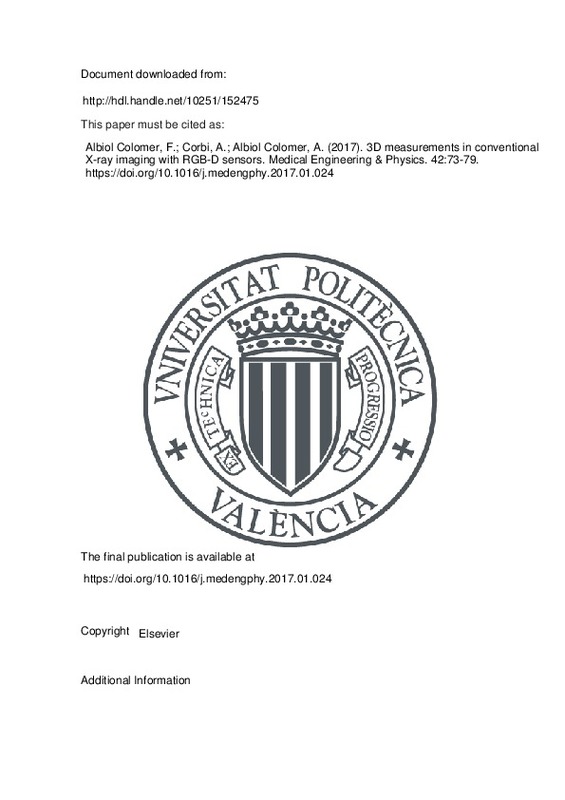JavaScript is disabled for your browser. Some features of this site may not work without it.
Buscar en RiuNet
Listar
Mi cuenta
Estadísticas
Ayuda RiuNet
Admin. UPV
3D measurements in conventional X-ray imaging with RGB-D sensors
Mostrar el registro sencillo del ítem
Ficheros en el ítem
| dc.contributor.author | Albiol Colomer, Francisco
|
es_ES |
| dc.contributor.author | Corbi, Alberto
|
es_ES |
| dc.contributor.author | Albiol Colomer, Alberto
|
es_ES |
| dc.date.accessioned | 2020-10-20T03:31:03Z | |
| dc.date.available | 2020-10-20T03:31:03Z | |
| dc.date.issued | 2017-04 | es_ES |
| dc.identifier.issn | 1350-4533 | es_ES |
| dc.identifier.uri | http://hdl.handle.net/10251/152475 | |
| dc.description.abstract | [EN] A method for deriving 3D internal information in conventional X-ray settings is presented. It is based on the combination of a pair of radiographs from a patient and it avoids the use of X-ray-opaque fiducials and external reference structures. To achieve this goal, we augment an ordinary X-ray device with a consumer RGB-D camera. The patient' s rotation around the craniocaudal axis is tracked relative to this camera thanks to the depth information provided and the application of a modern surface-mapping algorithm. The measured spatial information is then translated to the reference frame of the X-ray imaging system. By using the intrinsic parameters of the diagnostic equipment, epipolar geometry, and X-ray images of the patient at different angles, 3D internal positions can be obtained. Both the RGB-D and Xray instruments are first geometrically calibrated to find their joint spatial transformation. The proposed method is applied to three rotating phantoms. The first two consist of an anthropomorphic head and a torso, which are filled with spherical lead bearings at precise locations. The third one is made of simple foam and has metal needles of several known lengths embedded in it. The results show that it is possible to resolve anatomical positions and lengths with a millimetric level of precision. With the proposed approach, internal 3D reconstructed coordinates and distances can be provided to the physician. It also contributes to reducing the invasiveness of ordinary X-ray environments and can replace other types of clinical explorations that are mainly aimed at measuring or geometrically relating elements that are present inside the patient's body.(C) 2017 IPEM. Published by Elsevier Ltd. All rights reserved. | es_ES |
| dc.description.sponsorship | The authors would like to thank the Radiation Oncology Department of the Physics Section at La Fe Hospital for the anthropomorphic phantom used in this work and Jose Manuel Monserrate (Instituto de Física Corpuscular) for his contribution in the development of the calibration frame shown in Fig. 3. This research has the support of Information Storage S.L., University of Valencia (grant CPI-15-170), CSD-2007-00042 Con solider Ingenio CPAN (grant CPAN-13TR01), IFIC (Severo Ochoa Centre of Excellence SEV20140398) as well as the support of the Spanish Ministry of Industry, Energy, and Tourism (grant TSI1001012013019). | es_ES |
| dc.language | Inglés | es_ES |
| dc.publisher | Elsevier | es_ES |
| dc.relation.ispartof | Medical Engineering & Physics | es_ES |
| dc.rights | Reconocimiento - No comercial - Sin obra derivada (by-nc-nd) | es_ES |
| dc.subject | X-ray | es_ES |
| dc.subject | Depth cameras | es_ES |
| dc.subject | Epipolar geometry | es_ES |
| dc.subject | 3D reconstruction | es_ES |
| dc.subject | Movement tracking | es_ES |
| dc.subject | Dense surface mapping | es_ES |
| dc.subject.classification | TEORIA DE LA SEÑAL Y COMUNICACIONES | es_ES |
| dc.title | 3D measurements in conventional X-ray imaging with RGB-D sensors | es_ES |
| dc.type | Artículo | es_ES |
| dc.identifier.doi | 10.1016/j.medengphy.2017.01.024 | es_ES |
| dc.relation.projectID | info:eu-repo/grantAgreement/MINECO//SEV-2014-0398/ES/INSTITUTO DE FISICA CORPUSCULAR (IFIC)/ | es_ES |
| dc.relation.projectID | info:eu-repo/grantAgreement/UV//CPI-15-170/ | es_ES |
| dc.relation.projectID | info:eu-repo/grantAgreement/MEC//CSD2007-00042/ES/Centro Nacional de Física de Partículas, Astropartículas y Nuclear/ | es_ES |
| dc.relation.projectID | info:eu-repo/grantAgreement/MINECO//CPAN-13TR01/ | es_ES |
| dc.relation.projectID | info:eu-repo/grantAgreement/MINETUR//TSI-100101-2013-0019/ES/PROYECTO PARA EL DESARROLLO DE UN DISPOSITIVO DE IMÁGEN DENSITOMÉTRIA PARA LA MEDICIÓN PRECISA DE LA DOSIS EFECTIVA./ | es_ES |
| dc.rights.accessRights | Abierto | es_ES |
| dc.contributor.affiliation | Universitat Politècnica de València. Departamento de Comunicaciones - Departament de Comunicacions | es_ES |
| dc.description.bibliographicCitation | Albiol Colomer, F.; Corbi, A.; Albiol Colomer, A. (2017). 3D measurements in conventional X-ray imaging with RGB-D sensors. Medical Engineering & Physics. 42:73-79. https://doi.org/10.1016/j.medengphy.2017.01.024 | es_ES |
| dc.description.accrualMethod | S | es_ES |
| dc.relation.publisherversion | https://doi.org/10.1016/j.medengphy.2017.01.024 | es_ES |
| dc.description.upvformatpinicio | 73 | es_ES |
| dc.description.upvformatpfin | 79 | es_ES |
| dc.type.version | info:eu-repo/semantics/publishedVersion | es_ES |
| dc.description.volume | 42 | es_ES |
| dc.identifier.pmid | 28223012 | es_ES |
| dc.relation.pasarela | S\353792 | es_ES |
| dc.contributor.funder | Universitat de València | es_ES |
| dc.contributor.funder | Ministerio de Economía y Competitividad | es_ES |
| dc.contributor.funder | Ministerio de Industria, Energía y Turismo | es_ES |
| dc.contributor.funder | Ministerio de Educación y Ciencia | es_ES |







![[Cerrado]](/themes/UPV/images/candado.png)

